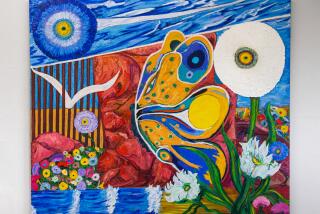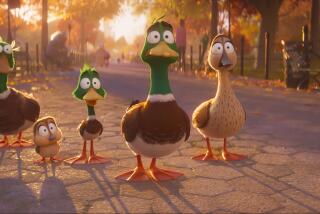Television review: National Geographic Channel’s ‘Great Migrations’
- Share via
In Tennessee Williams’ play “Suddenly, Last Summer,” the hatching of sea turtles in the Galapagos is described in desperately lovely detail by a woman who has just lost her son. “The narrow beach, the color of caviar, was all in motion, but the sky was in motion too … as the hatched sea turtles made their dash to the sea while the birds hovered and swooped to attack, and hovered — and swooped to attack!”
The image haunts the play, symbolizing her son’s fate, the fleet brutality of nature, the perilous race of survival, the fickleness of God. It lingers long after the details of the story have blurred. To see the hatching of sea turtles was beyond the ken of most mortals; to hear it described by a poet was enough.
Now such images are commonplace, brought to us in our living rooms via Discovery or National Geographic Channel. In the first episode of the latter’s new seven-part series “Great Migrations,” we are treated to enough images of natural wonder to keep a dozen poets, playwrights or scientists inspired for a lifetime. A wildebeest foal gamboling on the Serengeti, the crimson tide of red crabs crossing Christmas Island, the creation of a monarch butterfly via a time-lapsed version of “The Very Hungry Caterpillar.”
Divided loosely by motivating force — the first two episodes are titled “Born to Run” and “Born to Mate” — “Great Migrations” captures the amazing journeys of a vast array of creatures. Butterfly and bat, whale and albatross, ant and antelope herd and swarm and swim across hundreds and thousands of miles to feed, mate and give birth, all captured with breathtaking intimacy by cameras that register the play of watery light on a sperm whale’s back, the benign “expression” on a cannibalistic crab, the flutter of the webbing in the foot of a young albatross rising for its first flight.
It is impossible to overstate the miraculousness of such sights, the ability we now have to observe in such vivid detail, while remaining unobserved and non-intrusive. When you think of the generations of naturalists and scientists, the artists and scholars who spent years of their life journeying in the hopes of catching a glimpse here, a moment there, it is difficult not to feel almost guilty when presented such bounty of beauty and information. “Great Migrations” represents 21/2 years of field work in 20 countries across all seven continents, on land and sea and air. The images often simply defy description.
Unfortunately, producer David Hamlin did not agree, providing a constant and all too often overly florid script that they gave to Alec Baldwin, who may not have been the best choice to narrate the series. Though melodic and smooth, Baldwin’s voice too often takes on its famous slightly self-mocking tone that does not aid the florid prose — “hell hath no fury like a zebra protecting her foal,” “the Indian Ocean plays no favorites with her prodigal son.” The animals are “urged on by celestial forces,” “moving to the magic of the spheres.”
It’s difficult to begrudge the producers their poetry — on one level, the imagery begs for similarly breathtaking language. But in this case, less might well have been more; the narration works best when it is relaying information rather than describing a “sun-spangled yearning to move.”
Unlike in “Suddenly, Last Summer,” we do not have to rely on the playwright’s ability to conjure. We can see the glorious and the brutal, the awe-inspiring and heart-breaking forces of nature ourselves — the ferocity of the mother zebra, the deadly toll river crocodiles take on a herd of wildebeests, the surprising tenderness of mating bats. We can bring to them our own metaphors and meaning, and draw the inspiration that has moved so many to write, paint, chronicle and learn.
As long as we don’t take nature, or our increasingly profound ability to observe it, for granted.
More to Read
The complete guide to home viewing
Get Screen Gab for everything about the TV shows and streaming movies everyone’s talking about.
You may occasionally receive promotional content from the Los Angeles Times.







